Are Bees And Wasps Related?
This is a common question, and yes, bees
and wasps are related. It might even be said that a bee is a hairy wasp!
Both bees and wasps belong to the insect order Hymenoptera, and also to the suborder, Apocrita. The suborder Apocrita includes wasp-waisted insects that also have grub-like larvae that develop within a host species, gall or nest.
In fact, the consensus is that bees evolved from wasps.
“Wasps
(including hornets and yellow jackets) and bees are close relatives, sharing in
common a grandmother 100 million “greats” ago.” – Wilson & Messinger Carril,
authors of Bees In Your Backyard.
Steven Falk,
author of Field Guide to Bees of Great Britain and Ireland also states:
“There is
little doubt that within the Apoidea, the hunting wasps came first and provided
an ancestor that gave rise to bees”.
Falk also
notes that bees (and also ants) are actually specialized wasps, and interestingly,
certain hunting wasps are more closely related to bees than they are to other types
of wasps. These are wasps of the Crabonidae
(e.g. digger wasps) and Sphecidae (sand wasps).
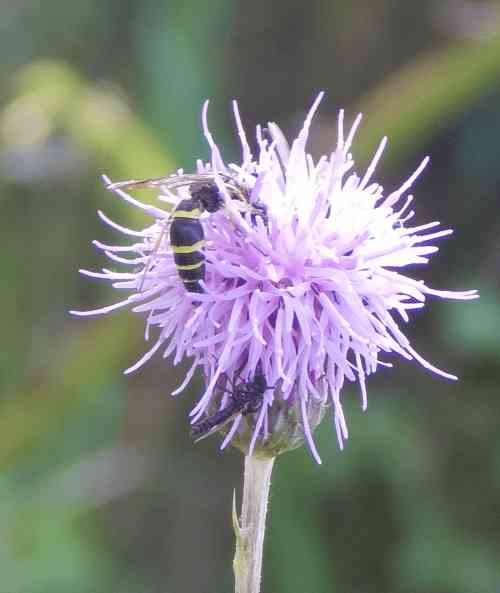 A Field Digger Wasp - Argogorytes mystaceus. This Crabonid wasp is more closely related to bees than to some other wasp species.
A Field Digger Wasp - Argogorytes mystaceus. This Crabonid wasp is more closely related to bees than to some other wasp species.Misidentification: bees may look like wasps
The image that many people have of a bee is actually stereotypical of just one type: the bumble bee (Bombus).
However, there are many
different types of bees and appearance is diverse – for example, some bees are
bright green and quite different from Bombus.
 Above: The image that many people have of a bee is actually stereotypical of just one type: the bumble bee (Bombus). This one is foraging on restharrow.
Above: The image that many people have of a bee is actually stereotypical of just one type: the bumble bee (Bombus). This one is foraging on restharrow.
Given the
diversity in appearance, and that bees and wasps are related, it’s no surprise
then, that misidentification between the two can occur, especially when the image that so many people have of a bee is limited to one type.
Example of bees that look (and sometimes behave) like wasps
For
non-scientists, confusion can easily arise with fairly common species.
Nomad bees
Below is a species of nomad bee (Nomada) - the Gooden's Nomad Bee, Nomada goodeniana.
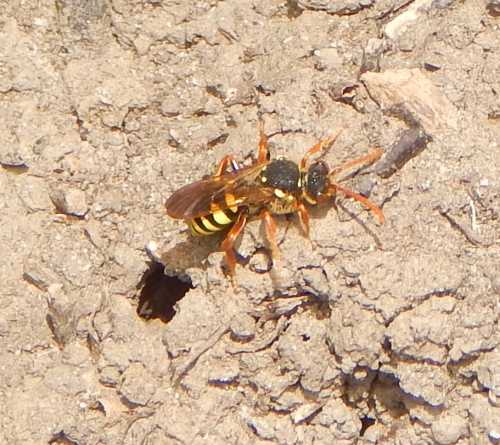 The cleptoparasitic Gooden's nomad bee just leaving a host bee nest. Note the 'waspish' appearance!
The cleptoparasitic Gooden's nomad bee just leaving a host bee nest. Note the 'waspish' appearance!
Nomad bees
are very wasp-like in appearance. They
are cleptoparasitic bees that target other bee species (the host).
What Is A Cleptoparasite?
Cleptoparasites are organisms that take over the nest or nest cell of a target host species.
In doing so, the cleptoparasite's offspring feed off the food supplies intended for that of the host. Nomad bees typically lurk outside bee nests (often Andrena – mining species), then enter and lay an egg inside a nest cell. The emerging nomad bee grub kills the host’s offspring and snaffles the food intended for it.
Below is the cleptoparasitic nyssonine wasp, Nysson spinosus (the Large-spurred digger wasp). It behaves in a similar way to the nomad bee species described above, but it targets a harmless wasp species.
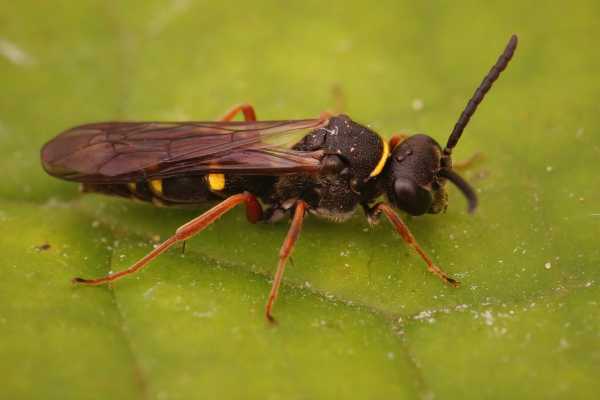 Cleptoparasitic nyssonine wasp, Nysson spinosus - similar in size to a nomad bee species.
Cleptoparasitic nyssonine wasp, Nysson spinosus - similar in size to a nomad bee species.Below is the host wasp species it targets, a member of the Crabonidae family, Argogorytes mystaceus (commonly known as the Field Digger Wasp).
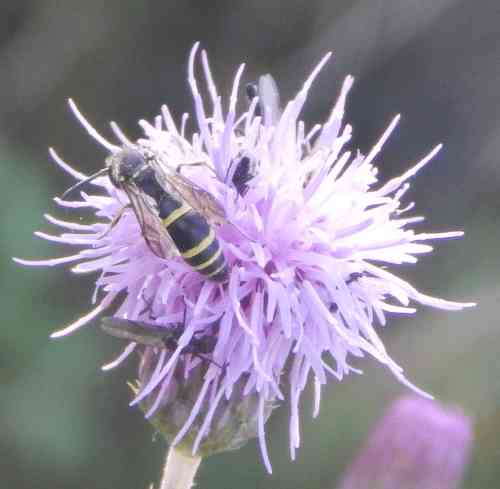 Argogorytes mystaceus, the Field Digger Wasp. It's very similar in size to a Nomad Bee.
Argogorytes mystaceus, the Field Digger Wasp. It's very similar in size to a Nomad Bee.Interesting Fact:
The Field Digger wasp is more closely related to bees than to social wasps of the Vespidae family - this includes the 'yellow jacket' types that most people are familiar with.
A key difference however, is that whereas most bees provide food for their young in the form of nectar and pollen, wasps – including the Field digger wasp, provide food for their grubs in the form of other small invertebrates, such as bug nymphs.
However, as always, there are exceptions on both sides!
Some bees eat meat, and recently, it has even been argued that bees are not vegetarian at all, but are omnivores).
Additionally, there are wasps that feed pollen to their offspring.
Wool carder bees
Another type of bee that can be mistaken for a wasp include wool carders that have more yellow on their bodies.
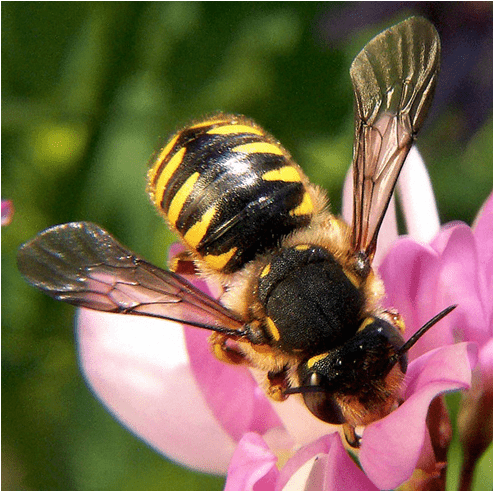 Anthidium manicatum, Wool Carder Bees can look similar to wasps, depending on the amount of yellow on the body.
Anthidium manicatum, Wool Carder Bees can look similar to wasps, depending on the amount of yellow on the body.
Even
scientists can make mistakes!
The
similarity between wasps and bees can even sometimes result in misidentification
for experienced scientists. A bee called
Neolarra was originally thought to be a wasp when it was first
discovered by scientists.
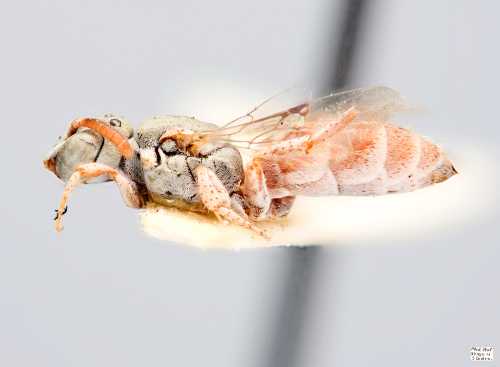 Neolarra pruinose female - photograph by The Packer Lab - Bee Tribes of the World - from Wikimedia Commons.
Neolarra pruinose female - photograph by The Packer Lab - Bee Tribes of the World - from Wikimedia Commons.Final note
For further information about general differences between bees and wasps, see my page: What's The Difference Between Bees, Wasps And Hornets?
For general background about how bees evolved from wasps, see may page: Wasps vs bees.
If you found this page helpful or interesting, I'd really be grateful if you would share it with others - if not this page, perhaps another, such as Gardening For Bees.
Thank you so much :) .